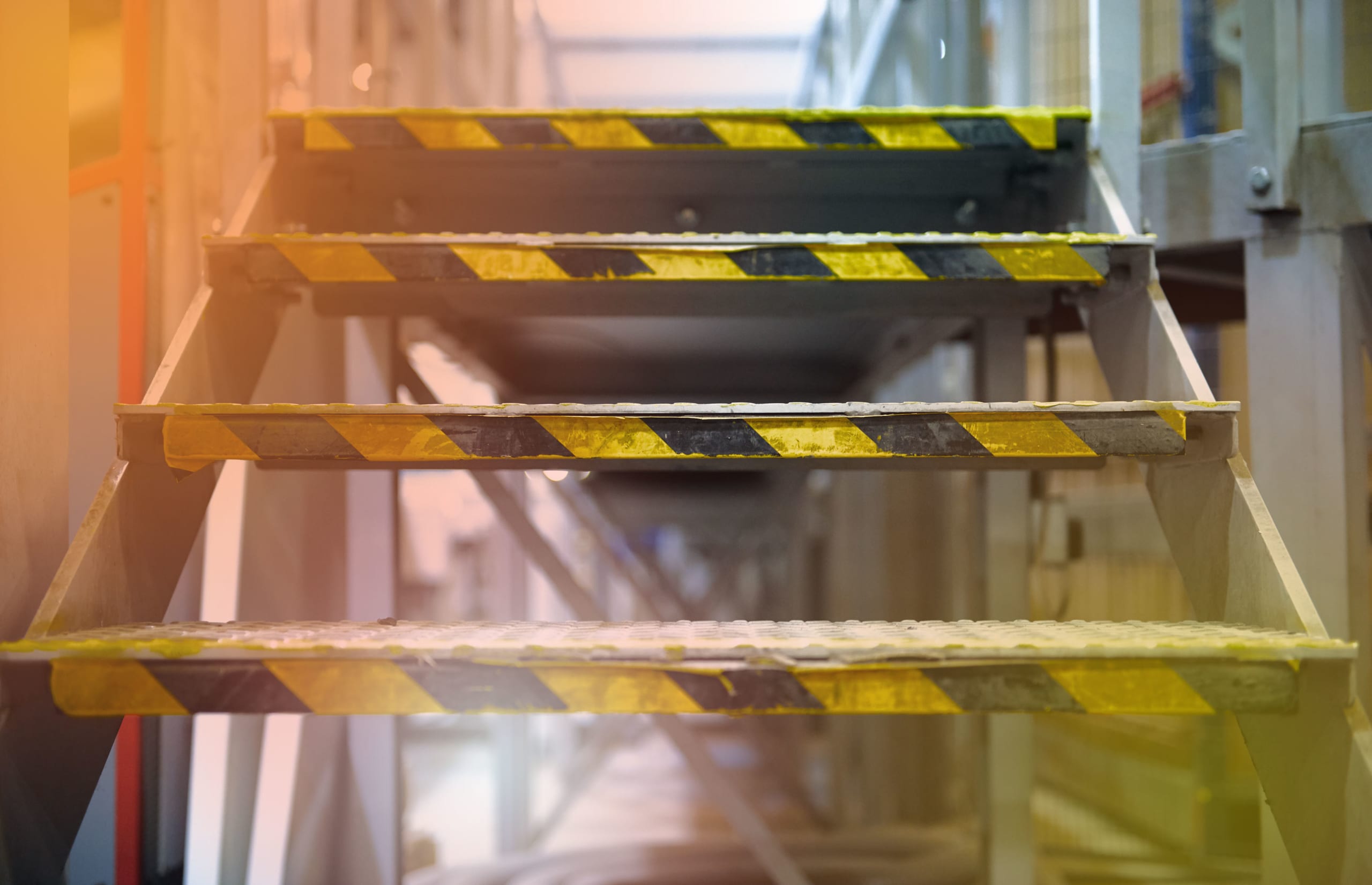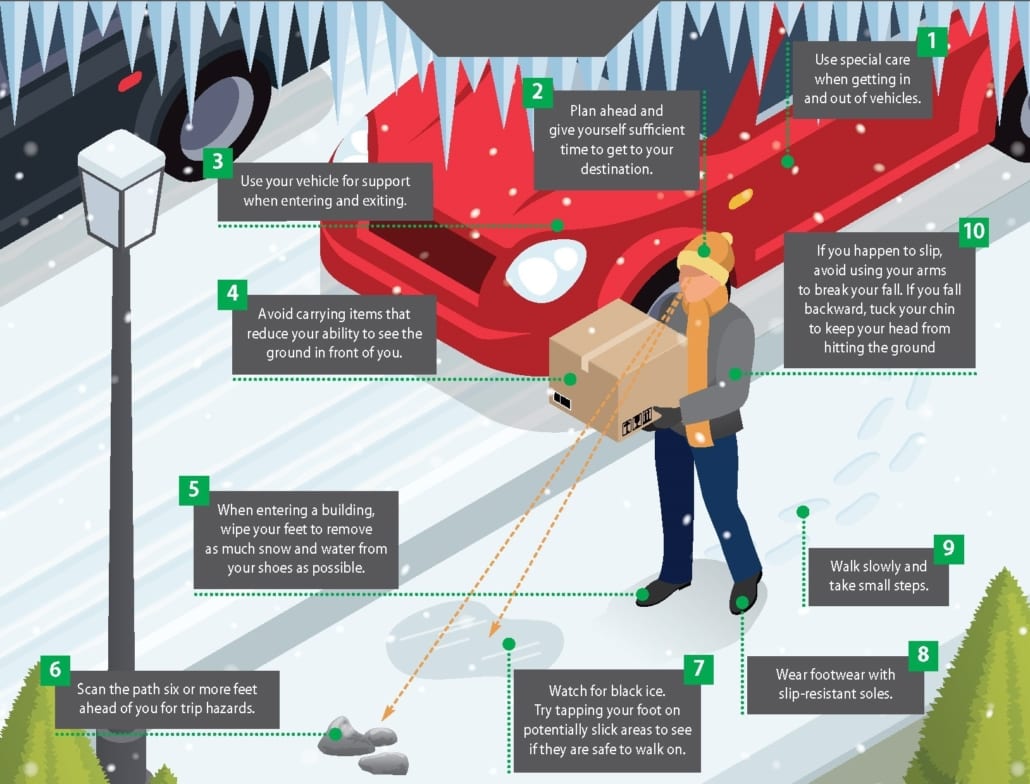
Slips, trips, and falls are frequent causes of incidents both on and off the job. According to OSHA, slips, trips, and falls constitute the majority of general industry incidents and result in back injuries, strains and sprains, contusions, and fractures. Additionally, they cause 15% of all incidental deaths and are second only to motor vehicles as a cause of fatalities.
What Causes Slips, Trips and Falls?
A slip occurs when there is too little traction or friction between the shoe and walking surface. A trip occurs when a person’s foot contacts an object or drops to a lower level unexpectedly, causing them to be thrown off-balance. A fall occurs when a person is too far-off balance. People slip on water or oil spills; they trip over small objects and electrical cords; and they fall off ladders, chairs, or down stairways.
There are many situations that can cause slips, trips, and falls and they can be prevented, but only if everyone does his/her part. First, always be alert to potential hazards in unfamiliar surroundings. Spot-check walkways and work areas to be sure that no trip or slip hazards exist. Even more importantly, when you find a fall hazard, make sure that something is done to correct it. The majority of slips, trips, and falls at work are caused by obvious hazards, most of which could have been easily corrected. Water and oil spills, small objects on the floor, electrical cords, and objects projecting out into walkways will eventually trip someone, so take a moment to eliminate these obvious hazards.
Tips for Avoiding Slips, Trips and Falls
- Always practice good housekeeping. Don’t leave loose objects on walking working surfaces.
- Never leave water or oil spills unattended. If they can’t be cleaned up immediately, set up a barrier so that people know about the hazard.
- Never allow an object to sit on stairways or ramps. Cartons, boxes, and other obstacles are especially dangerous here.
- Always use a ladder or stepstool. Never stand on a chair, desk, shelf, crate, box, or any other unstable items to reach something. If you must routinely reach items in high locations, purchase a ladder or stepstool to allow it to be done safely. Before each use, every ladder and stepstool should be inspected to make sure safety feet are present and there are no damages. Ladder safety training is required if you must use a ladder or for stepstools greater than 32 inches.
- Report or repair loose or damaged handrails, stairway treads, mats, and walkway runners. Sometimes even a small worn spot can cause someone to trip or fall.
- Wear proper footwear. Wear footwear that is appropriate for the conditions inside and outside.
- On smooth or wet surfaces, always wear shoes with slip resistant soles.
- Ensure proper lighting. Report burned out lights, as well as walkways and work areas that are too dark.
- When walking, don’t carry loads that block your vision. If you can’t see where you are going, a trip and fall is inevitable.
- Post signs to warn of dangerous areas. For example, paint edges where elevation changes occur with yellow paint to alert employees to the change in elevation.
- Use hand or safety rails on stairways. It’s the best way to keep your balance.
- Report any floor openings that are not protected. These openings can cause very serious falls.
- Keep away from the edge of unprotected floors/roofs that are elevated. If you lose your balance while working close to the edge, gravity is always going to win!
- Exercise caution when rising, sitting or reaching from a rolling task chair or stool.
- Always sit up straight and have hips far back on the seat. Do not sit on the edge of the seat.
- Always grasp the seat or arms while attempting to sit or rise. Inspect the chair regularly for wear and tear or damages. 5-legged chairs and stools are much more stable than 4-legged chairs and stools.
- Use soft-wheeled castors on hard flooring surfaces (i.e. tile) and hard-wheeled castors on soft flooring surfaces (i.e. carpet).
- Watch for imperfections in the flooring, such as damaged chair mats or floor tiles or ripped carpet, that may cause imbalance and falls from rolling task chairs or stools.

Photo source: New York Times
More News From Heritage
-
2/21/25
Heritage Announces East Liverpool, Ohio 2025 Environmental Grant Program
Learn about our East Liverpool Ohio grant opportunity!
-
2/18/25
Heritage Environmental Services Announces James (Shelby) Marlow as Chief Financial Officer
Heritage Environmental Services announced today that James (Shelby) Marlow will join the organization as Chief Financial Officer.
-
1/31/25
January Community Engagement Initiative: Home/Work Energy Reduction
Learn about our January community engagement initiative
-
1/29/25
Heritage Environmental Services Announces Chris Ebeling as Chief Commercial Officer
Heritage Environmental Services announced today that Chris Ebeling will join the organization as Chief Commercial Officer.
-
1/28/25
Heritage Environmental Services Addresses Industry Challenges with New State-of-the-Art Shredder
Heritage Environmental Services announced a new state-of-the-art shredding unit.
-
1/7/25
Navigating e-Manifest: What You Need to Know About Hazardous Waste Compliance
Learn about the e-Manifest Third Rule changes that begin January 22, 2025
-
12/23/24
Wreaths Across America 2024
This year, through collective effort and heartfelt generosity, we sponsored 727 wreaths and transported two truckloads of wreaths across the country.
-
12/2/24
Heritage Environmental Services Announces Rachel Evans as Chief Human Resources Officer
Heritage Environmental Services announced today that Rachel Evans will join the organization as Chief Human Resources Officer.








